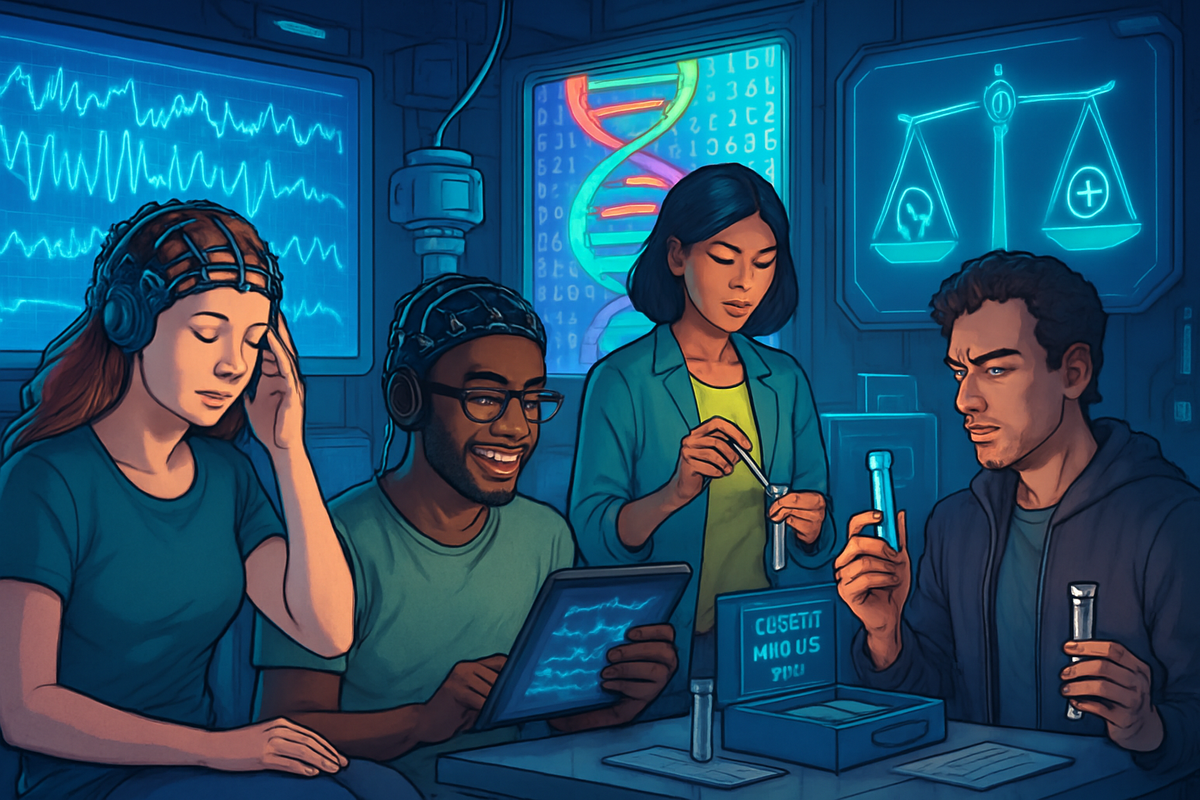Next-Gen Biohacking: Inside the World of Brain-Computer Interfaces, DIY Genetics & the Longevity Race
Unlock the future: from brain-computer interfaces to DIY genetics, explore how the $125 billion human enhancement industry is merging technology with biology, pushing boundaries from mere science fiction to groundbreaking reality.

By Funaix Editorial Team | July 30, 2025
"We can become something more." – Aron D’Souza, President of the Enhanced Games
Welcome to the Human Upgrade Era
It’s not science fiction anymore. From Silicon Valley billionaires swapping blood and hacking their DNA, to garage tinkerers building brain-computer interfaces (BCIs) out of spare parts, the $125+ billion human enhancement industry is exploding—and dragging our bodies and minds along for the wildest ride since the invention of coffee. If you’ve ever wondered what it’s like to plug your brain into a computer, edit your own genes, or chase immortality with a dash of reckless optimism, buckle up: the future is now, and it’s part cyborg, part biohacker, part philosopher, and 100% controversial.
The Rise of Brain-Computer Interfaces: Mind Meets Machine
Remember when wearable tech was just about counting steps? In 2025, BCIs are the headline act. Neuralink, Blackrock Neurotech, and Synchron are racing to bring thought-controlled computing to the mainstream, with early adopters already controlling cursors, robotic limbs, and even drones with nothing but pure brainpower. Elon Musk’s vision of merging human intelligence with AI is no longer just TED talk fodder—it’s being tested in labs and, yes, in a few bold (sometimes eyebrow-raising) volunteers.
- Medical Marvels: BCIs are restoring movement to paralyzed patients and giving voice to the voiceless.
- Performance Hacking: Next-gen BCIs promise to boost memory, focus, and even creativity—though clinical proof is still catching up with the hype.
- Experimental Extremes: Some biohackers are building open-source BCIs at home (seriously, check Reddit), blurring the lines between medical device and mad science.
“We’re seeing the first generation of cognitive wearables that literally let you train your brain like a muscle. But with great neural power comes great ethical headaches.”
– Dr. Elena Vasquez, Stanford University
DIY Genetics: Citizen Scientists and the CRISPR Frontier
If the word “biohacker” used to conjure images of kombucha-brewing wellness warriors, today’s DIYers are wielding CRISPR kits, gene therapy plasmids, and DNA sequencers—sometimes in their kitchens, sometimes in pop-up labs from Brooklyn to Bangalore. The goal? Everything from reversing hair loss to boosting muscle, immunity, or even IQ. (Warning: Don’t try this at home unless you’re fluent in both genetics and risk-taking.)
- Genetic Fitness: Startups now offer DNA-based fitness and nutrition plans. Want to know if you’re a born sprinter or marathoner? There’s a gene test for that.
- Longevity Genes: Some self-experimenters are injecting themselves with gene therapies designed to lengthen telomeres or boost follistatin—hoping to slow aging or build muscle.
- Regulatory Roulette: Many of these experiments operate in legal gray zones or offshore clinics, raising questions about safety, oversight, and medical tourism.
Fun fact: The number of DIY biohacking projects has shot up 40% since 2019, while the price of at-home gene editing tools drops every year.
The Longevity Race: Who Wants to Live Forever?
If BCIs are the mind’s frontier and DIY genetics the body’s, the longevity movement is the grand unifier. Billionaires like Bryan Johnson and Christian Angermayer are investing millions in anti-aging startups, plasma swaps, and wild protocols that sound like sci-fi but are now (almost) mainstream. Clinics offering stem cell infusions, senolytic drugs, and full-body biomarker panels are popping up everywhere—often with waitlists longer than a Taylor Swift concert.
- Wearable Wisdom: Oura Rings, Levels CGMs, and next-gen sleep trackers are standard-issue for anyone serious about extending healthspan.
- Supplements & Nootropics: NAD+ boosters, nootropic stacks, and peptide therapies are the new daily vitamins for the anti-aging set.
- Data-Driven Everything: AI-powered apps now crunch your genome, microbiome, and even your hourly mood swings to optimize every aspect of your life.
"We’re not just adding years to life—we’re adding life to years. But how far should we go before we lose sight of what it means to be human?"
– Alana Sandel, Marketing For Wellness
The Ethics & Wildcards: Who’s Steering This Ship?
Let’s be honest: the “upgrade yourself” movement comes with a side of existential dread. Should we edit our genes to be smarter, stronger, or live longer? Who gets access—just the wealthy, or everyone? Can governments keep up with tech, or are we entering the Wild West of human optimization?
- Regulation: The FDA and global agencies are scrambling to define the rules, but the pace of innovation is outstripping bureaucracy.
- Ethics: From privacy fears (hello, brainwave hackers) to questions about human identity, the debates are as heated as a Reddit AMA.
- Access & Equity: Will these enhancements widen the gap between the “upgraded” and everyone else, or can we democratize the tools?
Spoiler: The only thing everyone agrees on is that the genie is out of the bottle—and she’s wearing a smart ring.
Where Next? Navigating the Biohacker’s Playground
If your inner explorer is tingling, you’re not alone. Whether you’re a health optimizer, a tech enthusiast, or just someone who can’t resist a shiny new gadget, this is your moment to dive in, ask questions, and shape the next chapter of human evolution. The future is being written by the curious, the bold, and yes, the a-little-bit-crazy.
Want to stay ahead of the curve, get smart news, and enjoy exclusive perks? Become a Funaix Insider—subscribe for free and join a global community of forward-thinkers who believe the best way to predict the future is to help build it.
Disclaimers & Final Thoughts: The information in this article is for educational use only. Before attempting any form of biohacking, consult a qualified health professional—and maybe your favorite philosopher. Remember: just because you can doesn’t always mean you should.Curious for more? Check out our deep dives on wearable tech, AI-powered health, and the future of digital biology—all at Funaix.com.




